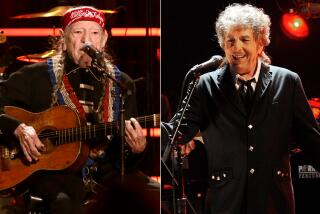MUSIC REVIEW : Salonen Gets Tough at the Bowl
It’s summertime at Hollywood Bowl, and, until now, the music has been easy.
That should not imply easy playing. It ain’t necessarily so. It certainly does imply easy listening.
No problem. The Bowl is a happy place for picnics, communal star-gazing and helicopter invasions. The mood is casual, the atmosphere is friendly, and the tunes are familiar.
Given the number of seats to be filled (nearly 18,000) and the number of rehearsals available (usually a single run-through per program), one can make a good argument for a festival of great hum-along hits.
Things were drastically different, however, on Thursday night. The podium was occupied for the second time this week and last time this season by Esa-Pekka Salonen, music-director-to-be of the Los Angeles Philharmonic--not by the customary visiting routinier. And the menu he served was strikingly bereft of chestnuts.
Salonen, a sage 34 despite his preposterously boyish appearance, is very much a child of his time. He has a special affinity for modern music, and he chose this occasion to survey three cornerstones of the 20th-Century repertory: Debussy’s “Jeux” (1912), Bartok’s First Piano Concerto (1926) and Stravinsky’s “Firebird” (1910).
Such a program wouldn’t be particularly shocking in a winter-season concert. In an al fresco setting that normally embraces Tchaikovsky slush pumps, pop-schlock orgies and camping trips amid fireworks in the Roman pines, Salonen’s selections seemed more than daring. They seemed downright revolutionary.
There was, of course, some method in the maestro’s madness. He is scheduled to conduct the same music with the Philharmonic at the sophisticated Salzburg Festival on Aug. 20.
At this juncture, one can’t be sure if his adventurous programming represents an attempt to update contemporary perspectives at the Bowl, an endurance test for his adoring yet presumably conservative public, or merely a convenient opportunity to practice what he will preach in Austria. The result, in any case, was a stimulating night at Cahuenga Pass for an attentive audience officially tabulated at 11,163.
The attendance figure, incidentally, seemed a bit generous to the quasi-trained eye. But in the glorious realm of cultural conditioning, optimism always is its own reward.
Salonen opened the evening by racing the assembled crowd through the de-rigueur rigors of the national anthem. Speedy, tough and unsentimental, he won hands down.
The man obviously does not respect cliches. He luxuriated in the sonic washes and rhythmic quirks of “Jeux,” proving at the same time that Debussy need not always evaporate in a wispy haze. Conversely, he approached the muscular bombast of the Bartok concerto almost as if it were an exercise in lyrical introspection.
The unorthodox approach made especially good sense here, given the presence of Krystian Zimerman as soloist. The 35-year-old Polish pianist offered crisp bravura where others strive for grotesque force, and he found a few valid opportunities for graceful introspection that might even have surprised the composer. He also revealed unflappable rhythmic security.
Despite a few rough edges, the collaboration was a model of mutual interpretive support, and a triumph of taste over tumult.
The intrusion of amplification made it impossible to tell if Zimerman--a Chopin specialist--actually commands the sheer power demanded by this formidable challenge. We’ll know more about that in Salzburg.
After intermission, Stravinsky’s dramatic meanderings sounded uncharacteristically lush and languorous. Everything is relative.
Salonen kept the narrative definition unusually taut, the linear articulation exceptionally precise. He savored subtle nuances of dynamics and color without allowing tension to sag in the process. The Philharmonic responded beautifully.
Still, the complete “Firebird” score seems a bit much of an uneven thing when it doesn’t accompany the specific action of the ballet. For at least one listener, the splashy suites--arranged by the composer himself--are more compelling in the concert hall.
More to Read
The biggest entertainment stories
Get our big stories about Hollywood, film, television, music, arts, culture and more right in your inbox as soon as they publish.
You may occasionally receive promotional content from the Los Angeles Times.










